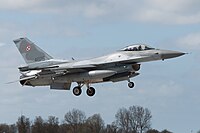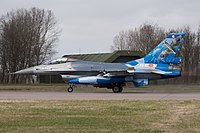- Royal Netherlands Air Force F-16MLU (Frisian Flag 2015)
- F/A-18C Swiss AF (Frisian Flag 2019)
- Luftwaffe Eurofighter (Frisian Flag 2018)
- Polish Air Force F-16C (Frisian Flag 2015)
- 142nd FW Oregon ANG F-15C (Frisian Flag 2015)
- 148th FW, Minnesota ANG, F-16C (Frisian Flag 2019)
- Swedish AF Saab JAS 39 Gripen (Frisian Flag 2010)
- French AF Mirage 2000D (Frisian Flag 2017)
- Royal Air Force Tornado GR4 (Frisian Flag 2017)
- Belgian AF F-16AM (Frisian Flag 2013)
- Finnish AF Boeing F-18C (Frisian Flag 2010)
- Dassault Falcon 20, Cobham PLC (U.K.) (Frisian Flag 2019)
avia.wikisort.org - Aerodrome
Exercise Frisian Flag Is a major NATO multinational aerial exercise, held annually at Leeuwarden Air Base, Netherlands, over the North Sea[3] and in the skies above the Netherlands, Germany and Denmark.[4]
Leeuwarden Air Base | |||||||||||||||
|---|---|---|---|---|---|---|---|---|---|---|---|---|---|---|---|
| |||||||||||||||
| Summary | |||||||||||||||
| Airport type | Military | ||||||||||||||
| Owner | Military of the Netherlands | ||||||||||||||
| Operator | Royal Netherlands Air Force (RNLAF) Koninklijke Luchtmacht (KLu) | ||||||||||||||
| Location | Leeuwarden, Netherlands | ||||||||||||||
| Built | 1938 | ||||||||||||||
| Elevation AMSL | 1 m / 3 ft | ||||||||||||||
| Coordinates | 53°13′43″N 05°45′38″E | ||||||||||||||
| Map | |||||||||||||||
 EHLW Location of Leeuwarden Air Base | |||||||||||||||
| Runways | |||||||||||||||
| |||||||||||||||
Missions flown during Frisian Flag included defensive and offensive air missions, protection of friendly aircraft and Close Air Support (CAS) strikes. Some missions call for Forward Air Controller units coordinate with fighter elements to attack ground targets. Surface-to-air missile systems enabled realistic exercise scenarios missions.[5]
A combat search and rescue element has been added to recent Frisian Flag exercises. Usually involving the rescue of downed air crew by ground forces with the assistance of fighters and helicopters.[6]
History
The exercise was first held in 1992 following NATO intervention in Bosnia and Herzegovina, originally called exercise DIATIT, the first three letters coming from the word DIANA, 322 Tactical Training Evaluation and Standardization (TACTES) Squadron's nickname (the organizing unit) and the last three letters coming from the words Tactical Integrated Training.[7] It changed its name to 'Frisian Flag' in 1999. The name ‘Frisian Flag’ was chosen because ‘Frisian’ is named after the province of Friesland, the home of Leeuwarden Air Base and because of similar ‘Flag’ exercises such as ‘Red Flag’ (U.S) and ‘Maple Flag’ (Canada).
Operational planning of Exercise Frisian Flag is organised by 322 Tactical Training Evaluation and Standardization (TACTES) Squadron of the Royal Netherlands Air Force (RNLAF).[8]
Frisian Flag is open to North Atlantic Treaty Organisation (NATO) and Partnership for Peace (PfP) members, participating aircraft fly twice-daily missions during the exercise, which is designed to prepare participating aircrew for complex hostile environments, including missions that may occur in a high intensity conflict. It provides the opportunity for air forces to plan and execute complex missions including offensive and defensive training in a realistic scenario.[9] Defensive Counter Air (DCA) missions are flown with close coordination with ground-based surface-to-air missile units.[10]
Modern Era
The aerial exercises takes place in two waves daily, morning and afternoon during the two-week period. There is no flying in the evenings and on weekends.[11]
During the exercise, the pilots co-operate with the land and naval forces, including the JTACs (Joint Terminal Attack Controllers). The fighter component will also receive support from a NATO AWACS platform. The European Air Refuelling Training (EART) exercise is integrated with Exercise Frisian Flag. French, Dutch, Italian and German tankers operate from Eindhoven air base.[12]
Aircraft are divided into friendly 'Blue' and hostile 'Red' forces at the start of the exercise.[13] Exercise Frisian Flag has evolved into one of the largest NATO exercises,[14] involving more than 70 aircraft from NATO and Partnership for Peace countries.[15]
During Frisian Flag command and control of aircraft is provided by Dutch and German Control and Reporting Centres (CRCs) supported by NATO AWACS (Airborne Warning and Control System) aircraft from NATO Air Base Geilenkirchen.[16]
No live ammunition is used during the exercise. All air-to-air and air-to-ground weapon launches are simulated..[17]
Aggressors
Fighters from participating units, as well as Douglas A-4 Skyhawks from Discovery Air Defence play the role of 'Red' hostile forces.[18] British company Cobham plc provide Falcon 20 aircraft to simulate enemy electronic jamming during Frisian Flag exercises.[19] The Royal Norwegian Air Force has also provided electronic warfare Dassault Falcon 20 aircraft in previous Frisian Flag exercises.[20]
A Gates Learjet 36A from Dutch company Skyline Aviation was used to provide hostile 'enemy' jamming during Frisian Flag 2013.[21]
Surface to Air Threat
Realistic ground based threats include surface-to-air missile (SAM) systems like the SA-6 'Gainful' and Roland mobile short-range SAM system and 'Smokey Sam' missiles that are fired at aircraft to simulate hostile enemy threat environment.[22] Dutch Patriot SAM batteries have also been integrated into Frisian Flag.[23] The SAM units are based at the Marnewaard training area and the Vliehors range (NATO codename 'Cornfield') on the Dutch island Vlieland.[24][25]
Gallery
Past Participants
References
- "Airport information for EHLW". World Aero Data. Archived from the original on 2019-03-05.
{{cite web}}: CS1 maint: unfit URL (link) Data current as of October 2006. Source: DAFIF. - Airport information for LWR at Great Circle Mapper. Source: DAFIF (effective October 2006).
- "NATO fighters and refuellers to train in Netherlands". Retrieved 8 October 2019.
- "NATO Allies and partners head home as exercise Frisian Flag concludes". Retrieved 8 October 2019.
- "International air exercises in Netherlands drawing to a close". Retrieved 8 October 2019.
- "International air exercises in Netherlands drawing to a close". Retrieved 8 October 2019.
- "Frisian Flag 1999". Retrieved 8 October 2019.
- "Exercise Frisian Flag 2016". Retrieved 8 October 2019.
- "NATO Allies and partners head home as exercise Frisian Flag concludes". Retrieved 8 October 2019.
- "Frisian Flag 2012 – contractor support of air operations". Retrieved 8 October 2019.
- "Annual Frisian Flag fighter jet exercise starting next week in Leeuwarden". Retrieved 8 October 2019.
- "5th European Air-to-Air Refuelling Training takes off in the Netherlands". Retrieved 8 October 2019.
- "Frisian Flag 12". Retrieved 8 October 2019.
- "NATO air forces wrap up exercise Frisian Flag". Retrieved 8 October 2019.
- "Exercise Frisian Flag 2018: more than 70 NATO military aircraft in the Netherlands". Retrieved 8 October 2019.
- "NATO Allies and partners head home as exercise Frisian Flag concludes". Retrieved 8 October 2019.
- "Frisian Flag a Dutch Master Class". Retrieved 8 October 2019.
- "Polish F-16 Fighters Taking Part In The Frisian Flag Exercise". Retrieved 8 October 2019.
- "Frisian Flag 2018". Retrieved 8 October 2019.
- "Frisian Flag 13". Retrieved 8 October 2019.
- "War Operations Above Friesland". Retrieved 8 October 2019.
- "Frisian Bayou". Retrieved 8 October 2019.
- "Frisian Flag 2012 – contractor support of air operations". Retrieved 8 October 2019.
- "Two Exercises, One Goal'". Retrieved 8 October 2019.
- "Cornfield Range Vlieland". Retrieved 8 October 2019.
- "Frisian Flag 2014". Retrieved 8 October 2019.
- "Frisian Flag 2014".
- "Air Force Medical Service Photos". Retrieved 8 October 2019.
- "Frisian Flag 2019". Retrieved 8 October 2019.
- "Frisian Flag 2012". Retrieved 8 October 2019.
- "Frisian Flag". Retrieved 8 October 2019.
- "Polish F-16 Fighters To Take Part In The Frisian Flag Exercise".
- "Frisian Flag 2017". Retrieved 8 October 2019.
- "Frisian Flag 2018".
- "Military Exercise – Exercise Frisian Flag 2013".
- "Exercises and Deployments – Frisian Flag 2019 - Leeuwarden Airbase". May 3, 2019.
- "U.S. Air Force Airmen participate in Frisian Flag 2019".
- "UK RAF deploys six Tornado GR4 aircraft for Frisian Flag exercise in Netherlands".
Другой контент может иметь иную лицензию. Перед использованием материалов сайта WikiSort.org внимательно изучите правила лицензирования конкретных элементов наполнения сайта.
WikiSort.org - проект по пересортировке и дополнению контента Википедии











